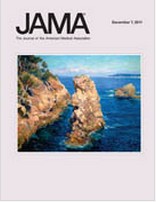JAMA:鱼油或能延长移植物畅通时间
2012-05-10 张章 中国科学报
近日,刊登在《美国医学会杂志》(JAMA)上的一项新研究披露,在血管通路中使用新型合成型动静脉移植物(一种嫁接在动静脉之间的合成物管子)的血液透析患者,每日摄取鱼油,12个月内对移植物通畅性丧失比例有一定影响,但是该比例不会显著降低。鱼油是鱼体内的全部油类物质的统称,它包括体油、肝油和脑油。 研究报告指出:“理想的血液透析需要可靠的血管通路,包括动静脉瘘(用手术方法在动脉与静脉间创建一种连接)、

近日,刊登在《美国医学会杂志》(JAMA)上的一项新研究披露,在血管通路中使用新型合成型动静脉移植物(一种嫁接在动静脉之间的合成物管子)的血液透析患者,每日摄取鱼油,12个月内对移植物通畅性丧失比例有一定影响,但是该比例不会显著降低。鱼油是鱼体内的全部油类物质的统称,它包括体油、肝油和脑油。
研究报告指出:“理想的血液透析需要可靠的血管通路,包括动静脉瘘(用手术方法在动脉与静脉间创建一种连接)、合成性动静脉移植物及中央静脉导管等,在美国接受血液透析的病人中,它们的使用率分别为55%、21%及24%。在上世纪90年代早期,北美主要使用动静脉移植物,但它因为并发症发生率和成本较高而‘失宠’。”
多伦多大学的Charmaine E. Lok及其同事们开展了一项随机对照实验,该实验比较了植入动静脉移植物后的终末期肾病患者中接受鱼油补充剂与接受相关对照剂后,两者的动静脉移植物的通畅性和血栓发生率等方面内容。该研究是在2003~2010年间在15家北美透析中心开展的,这些中心招收了201名患有第5期慢性肾病的成年患者(50%为妇女、63%为白人、53%患有糖尿病),并对他们进行了为期12个月的移植后随访。在移植物植入之后第7天,这些参与者被随机分派服用鱼油胶囊(4颗1克的胶囊/天)或相匹配的其他对照剂。
研究人员发现,服用鱼油者和服用对照剂者在移植物通畅性丧失的比例上没有明显的差异(分别为48%、62% )。“当然,通畅性丧失比例在鱼油服用组中要低,而血栓形成的频度在该组中也下降了一半。”Lok说。
研究人员还注意到,动静脉移植物的使用在过去10年中不断减少,这主要是由于医生们更加强调瘘管的使用。“但是动静脉移植物可能对那些接受血液透析的病人更加合适,这些病人的静脉并不适合建立瘘管,或这些人先前经历过瘘管不成熟等问题。”Lok指出。然而与功能性瘘管相比,动静脉移植物可能需要3~4倍的干预频度以维持相同的通畅时间。一旦发现可延长动静脉移植物通畅时间,并降低治疗移植物并发症干预频度的安全、廉价的药物,可能会鼓励人们增加对这些移植物的使用。

doi:10.1001/jama.2012.3473
PMC:
PMID:
Effect of Fish Oil Supplementation on Graft Patency and Cardiovascular Events Among Patients With New Synthetic Arteriovenous Hemodialysis Grafts A Randomized Controlled Trial
Lok, Charmaine E.; Moist, Louise; Hemmelgarn, Brenda R.; Tonelli, Marcello; Vazquez, Miguel A.; Dorval, Marc; Oliver, Matthew; Donnelly, Sandra; Allon, Michael; Stanley, Kenneth
Context Synthetic arteriovenous grafts, an important option for hemodialysis vascular access, are prone to recurrent stenosis and thrombosis. Supplementation with fish oils has theoretical appeal for preventing these outcomes. Objective To determine the effect of fish oil on synthetic hemodialysis graft patency and cardiovascular events. Design, Setting, and Participants The Fish Oil Inhibition of Stenosis in Hemodialysis Grafts (FISH) study, a randomized, double-blind, controlled clinical trial conducted at 15 North American dialysis centers from November 2003 through December 2010 and enrolling 201 adults with stage 5 chronic kidney disease (50% women, 63% white, 53% with diabetes), with follow-up for 12 months after graft creation. Interventions Participants were randomly allocated to receive fish oil capsules (four 1-g capsules/d) or matching placebo on day 7 after graft creation. Main Outcome Measure Proportion of participants experiencing graft thrombosis or radiological or surgical intervention during 12 months' follow-up. Results The risk of the primary outcome did not differ between fish oil and placebo recipients (48/99 [48%] vs 60/97 [62%], respectively; relative risk, 0.78 [95% CI, 0.60 to 1.03; P = .06]). However, the rate of graft failure was lower in the fish oil group (3.43 vs 5.95 per 1000 access-days; incidence rate ratio [IRR], 0.58 [95% CI, 0.44 to 0.75; P < .001]). In the fish oil group, there were half as many thromboses (1.71 vs 3.41 per 1000 access-days; IRR, 0.50 [95% CI, 0.35 to 0.72; P < .001]); fewer corrective interventions (2.89 vs 4.92 per 1000 access-days; IRR, 0.59 [95% CI, 0.44 to 0.78; P < .001]); improved cardiovascular event–free survival (hazard ratio, 0.43 [95% CI, 0.19 to 0.96; P = .04]); and lower mean systolic blood pressure (?3.61 vs 4.49 mm Hg; difference, ?8.10 [95% CI, ?15.4 to ?0.85]; P = .01). Conclusions Among patients with new hemodialysis grafts, daily fish oil ingestion did not decrease the proportion of grafts with loss of native patency within 12 months. Although fish oil improved some relevant secondary outcomes such as graft patency, rates of thrombosis, and interventions, other potential benefits on cardiovascular events require confirmation in future studies.
本网站所有内容来源注明为“williamhill asia 医学”或“MedSci原创”的文字、图片和音视频资料,版权均属于williamhill asia 医学所有。非经授权,任何媒体、网站或个人不得转载,授权转载时须注明来源为“williamhill asia 医学”。其它来源的文章系转载文章,或“williamhill asia 号”自媒体发布的文章,仅系出于传递更多信息之目的,本站仅负责审核内容合规,其内容不代表本站立场,本站不负责内容的准确性和版权。如果存在侵权、或不希望被转载的媒体或个人可与williamhill asia 联系,williamhill asia 将立即进行删除处理。
在此留言













#植物#
51
#移植物#
50